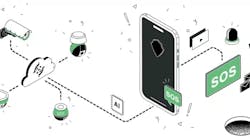[Editor's note: John Honovich publishes this and other information on network video at IPVideoMarket.info.]
What do You Need to Know?
Security managers do not need to become IT experts to manage deployments of IT based security systems. However, they do need to know the main limitations and concerns of using IT systems.
Very few individuals are IT experts, even in IT. Ask an IT engineer about their manager and they are likely to say "How did this guy become my boss?" Do the same for IT salespeople and the response is usually, "Why did he tell them we could do that?"
For better or worse, projects get done in IT with most people lacking critical IT skills. Do not worry about becoming an IT expert - most of your peers in IT are not even experts.
The Key Issues
Here are the 5 key issues you should understand:
• Using IP Addresses
• Using network bandwidth
• Ensuring your systems meet IS standards
• Enabling remote access
• Handling installation and service
For most projects, if you address and handle each of these 8 issues, your project should proceed smoothly.
IP Addresses
Every device connected to the network is assigned an IP address - your laptop, your desktop, your IP phones, your DVRs, etc., etc. However, there are a limited number of IP addresses available. In most organizations, especially large ones, IP addresses are carefully tracked and allocated deliberatively.
Most security systems, whether it is a DVR or an access control panel, need an IP address so that you can remotely view or control the device. Moreover, you usually need that address permanently so you typically request a static, non-changing address.
If you are using analog cameras, they do not need an IP address because they are connected by a dedicated cable to a DVR. However, each IP cameras does need an IP address. If you are going with IP, you certainly need far more IP addresses than with a DVR. On average about 10 - 20 times as many IP addresses are needed for IP than for analog.
Most IT organizations will have IP addresses available but you need to clearly request (1) how many and (2) the use of those IP addresses. In bigger organizations, getting an approval can sometimes take weeks. In smaller organizations, it can be as simple as confirming with the on-site IT manager.
Network Bandwidth
Bandwidth is a critical aspect of IP based video systems. It is important to understand how much bandwidth is available in a network compared to how much bandwidth a video surveillance system requires. Please read my tutorial on bandwidth for the basics on this key issue.
The most important element impacting bandwidth is what you do about recording. This is because most video surveillance applications record far more frequently than they are viewed.
Using DVRs
If you record using a DVR with analog cameras, there will be no bandwidth impact when it comes to recording. The only time bandwidth will be used is when a remote viewer requests video.
Using IP Cameras
If you record using IP cameras or encoders, bandwidth will be consumed from the location of those devices to the place where the recorder is. The key concern is whether the recorder is in the same building as the cameras. Usually when they are, significant amount of bandwidth is available. However, if you try to place a video recorder in a different building than the cameras, you often hit major problems with insufficient bandwidth.
When using IP cameras or encoders, you do need to know the capabilities of your local network. For instance, some banks and retailer still have low speed hubs in their sites. IP cameras would crash these networks. On the other hand, many universities have super high speed networks that can easily transport all of your cameras.
Separate Infrastructure
A common practice when IP cameras are close to the recorder is to simply install dedicated networking equipment to connect the cameras to the recorder. This is a low cost technique that eliminates most bandwidth concerns. In this way, IT does not worry about surveillance video impacting the general company network.
Enabling Remote Access
Whether you are IP or analog, you will need to provide access to view video remotely. Inside of the corporate network, this is usually just an issue with bandwidth. The most accepted technique by IT departments and supported by video recorder vendors is to implement a bandwidth throttle. What IT is most concerned about is that one day, you will need to view lots of video remotely and you will bring the network down.
Bandwidth Throttles
Bandwidth throttling is a software feature supported in most video recorders that restricts the recorder from only sending a set amount of bandwidth to remote viewers. For instance, let's say you have a branch office or a remote store that only has a DSL or cable modem connection. The bandwidth throttle can be set so that the recorder never uses more than 25% or 50% (or whatever level you set) of the amount of bandwidth available.
This almost always eliminates IT concerns over bandwidth. They may want to test it but once that passes, it usually is approved.
Information Security
IT cares about security systems that connect to the network because those devices can be sources of carriers of information security problems. Fundamentally, the concern over security systems is the same as letting your teenager's laptop connect to a corporate LAN. IT does not know what is on those systems and what, if anything, is being done to protect them.
There are 2 fundamental ways IT can readily approve a device to connect to the network:
• The device (e.g., DVR) is treated exactly the same as any PCs in the network (same anti-virus, firewalls, restrictions on applications, etc.)
• The device is deemed a network appliance (like a switch, router, ip telephone) and does not need any additional security measures.
What IT departments definitely do not want is a security device that is essentially someone else's home-built PC. In other words, if your DVR is essentially a PC loaded with a Windows OS and an application to manage video, many IT organizations are going to see this device as an unacceptable risk.
This is why software only video management systems are so favorable to Information Security inspections. The VMS is simply seen as another application running on a standard PC with standard Information Security standards applied.
Alternatively, if IT accepts your security device is an appliance similar to a router or ip telephone, they will often allow the device to be installed with no further action. This is one of the reasons that Linux or embedded DVRs have become so popular. Indeed, most telephone or switches are simply Linux or embedded applications running on a computer.
IT departments verify and approve in a variety of ways. Some simply have a phone call. Others will want to check product documentation. More demanding organizations will require vendors to complete an information security review. the most demanding will actually have a unit sent in for testing and analysis.
Handling Installation and Service
IP addresses, bandwidth and information security are generally the big 3 disqualifiers for connecting security systems to IT networks. Beyond that, the next big issue is who does the work - meaning who is going to install and service the equipment.
Historically, security equipment was entirely managed, from install to lifetime service, by security integrators. IT was not directly responsible and would only get involved if there was a specific issue like (a) the network is out, (b) an IP address conflict, or (c) an information security problem. Still today, lots of projects are managed in this way.
Every physical security manager needs to determine how they want to handle this. Many will continue to use their security integrator because it is a known and established practice.
To the extent that IT becomes responsible for doing the installation or the service, the more they will want hardware that is consistent with their existing selections. For instance, if IT is responsible, they will prefer purchasing servers and storage from their existing suppliers (rather than from a video surveillance manufacturer).
A key aspect is understanding the IT department's level of interest in doing this. Some want no part in security projects, others will be aggressive about managing it. This will be a function of budget and ambition on the part of IT. On the positive side, IT may be able to reduce costs of hardware because of their volume contracts and direct purchasing. On the downside, IT may not want or be able to take on this project (especially because of increasing budget cuts).
Conclusions
While the best technology for your specific risks should drive your product selection, a number of important IT elements must be taken into consideration. By appreciating and ensuring that each of these 5 areas are factored in, you should be able to smoothly gain IT's support for your project.

